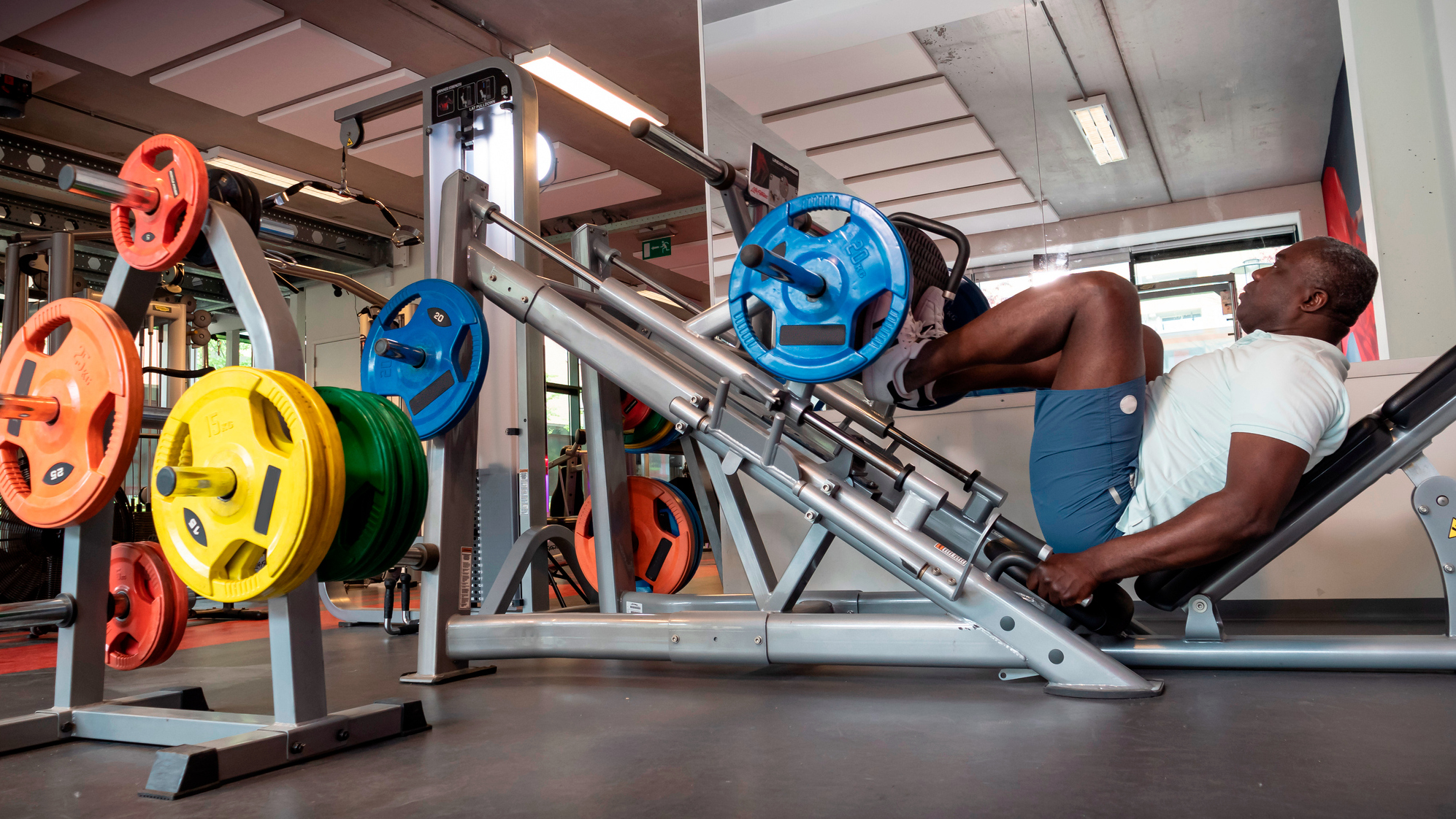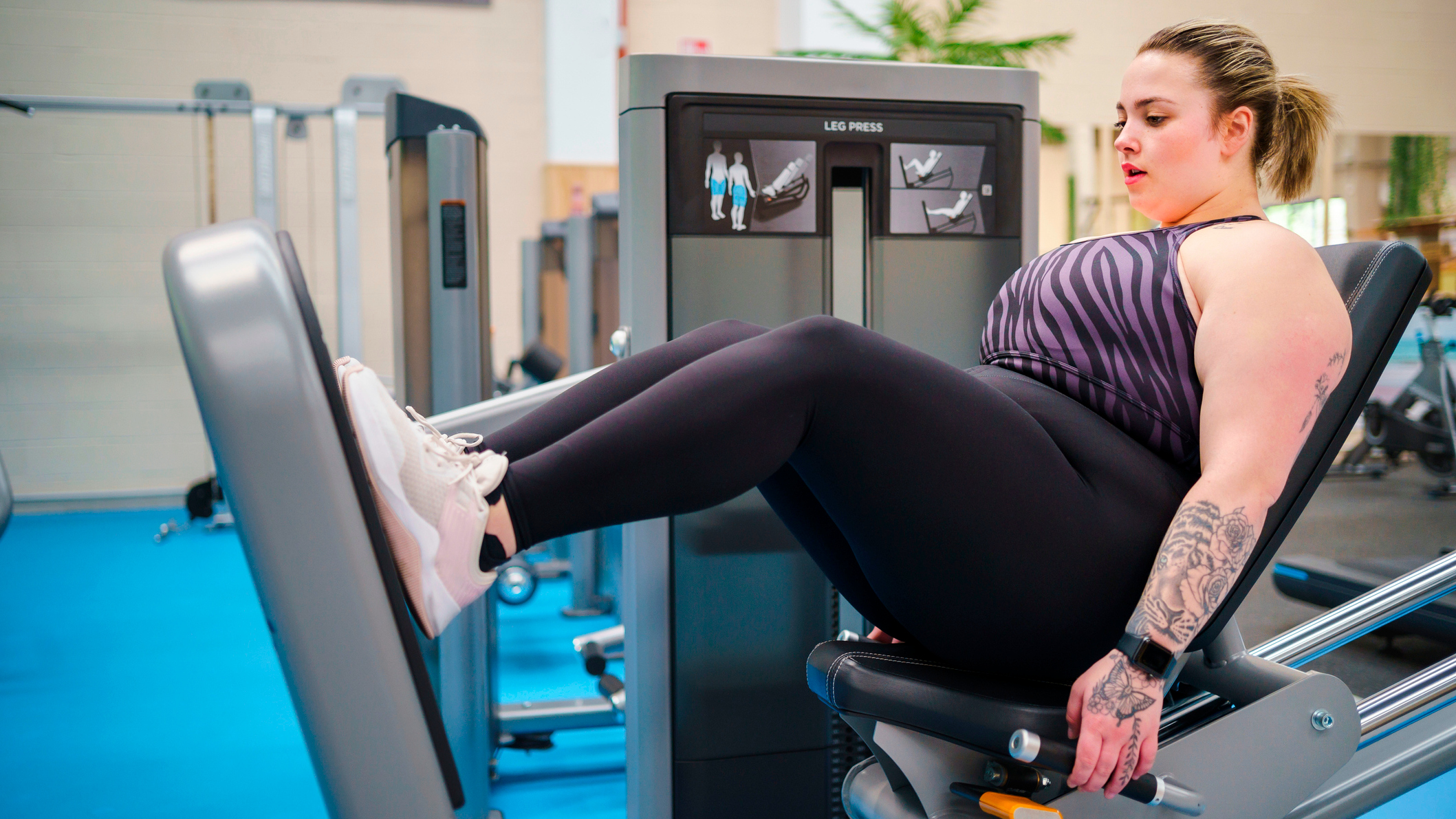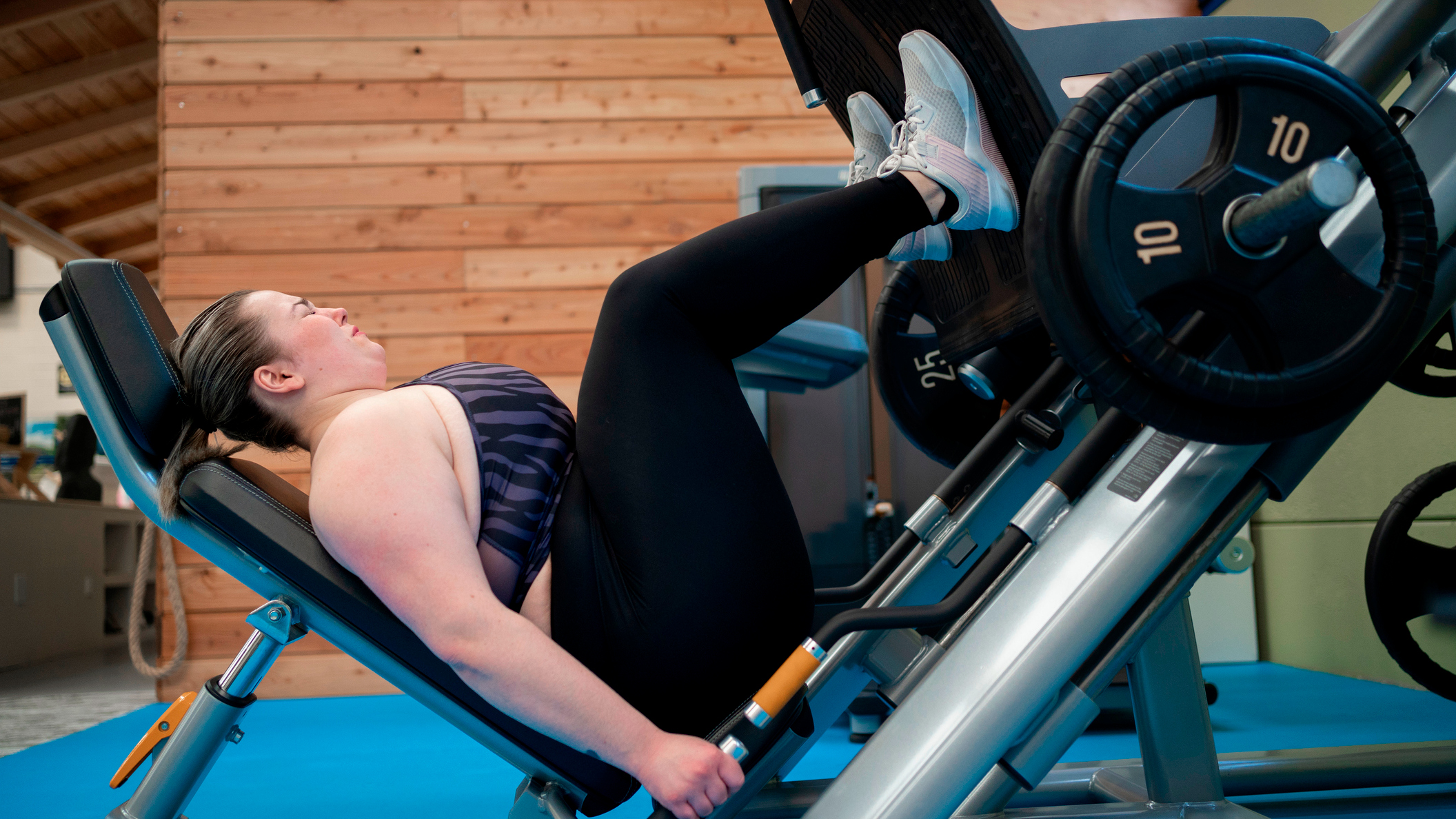How To Do The Leg Press
Expert advice on how to do the leg press safely, as well as how it compares to the barbell squat

The leg press is sometimes looked down on as an inferior leg exercise to the back squat. But while there’s no doubt the barbell move is one of the finest lower-body exercises, that shouldn’t blind you to the many benefits of the leg press. For an exercise with quite a short range of motion, it’s highly effective at training the quads, glutes and hamstrings.
Like the rest of your gym’s weights machines, it may not train all the stabilizing muscles in your joints or recruit the core muscles in the same way that free-weights exercises do. But working in a fixed movement pattern with a resistance machine can be very useful for isolating the exact muscle you’re looking to train and moving a lot of weight safely.
We want to help you make good use of this leg-strengthening stalwart, so we asked USA Weightlifting-certified coach Karl Bratland to explain how to use the leg press machine properly, how to avoid common mistakes and when to use it instead of a traditional barbell back squat.
Karl Bratland is a functional fitness and nutritional coach with an online fitness coaching business offering custom fitness and nutrition plans. He has a master’s degree in Exercise Science and several fitness certifications including a USA Weightlifting L1 and CrossFit Trainer.
Types Of Leg Press Machine
Most gyms will have two kinds of leg press machine.

The horizontal leg press machine involves sitting in a moveable chair with your feet resting on a horizontal plate. You select the weight by moving a pin in a weight stack and then push the seat away from the plate by straightening your legs. This type of leg press machine is better for beginners and doing variations like single-leg leg presses and leg press calf raises.

The angled or 45° leg press machine involves you sitting at an angle that puts your feet against a platform above your head. You select the weight by moving a pin, then use a safety catch to release the weight. Lower the platform towards you by bending your knees, then straighten your legs.
How To Do A Leg Press
Here’s Bratland’s expert guide for the 45° leg press machine.
Get the Coach Newsletter
Sign up for workout ideas, training advice, reviews of the latest gear and more.
“You want your feet a little bit outside shoulder-width apart, toes slightly angled out, although this is going to depend on what’s comfortable for you,” says Bratland.
“If you have longer legs or femurs [thigh bones] your feet will probably need to be a little bit wider. If you’re shorter you can put your legs a little narrower. It’s harder to go as deep [with a narrow stance] if you’re taller.”
You will need to twist or move a handle near the seat to release a safety catch. Make sure you’re supporting the platform with slightly bent knees before you do this and you’re ready to take the weight.
“Unrack the weight and control it down by bending your knees,” says Bratland. “Try to get to a point where your thighs are parallel to the platform. Then drive through your feet to return to the starting position.
“At the top of the rep, you want to have your knees slightly bent so your leg muscles stay engaged.”
Leg Press Foot Position
“If you put your feet higher up [on the platform] it will hit your glutes and your hamstrings a little bit more,” says Bratland. “Putting your feet lower on the platform will hit your quads a little bit more.
“It’s the same thing with putting your feet a little bit narrower. This will work your quads more, and if you put them wider it will be more glute- and hamstring-focused.
“Slight changes like this can help target certain muscles slightly more, but all variations are still going to hit your glutes, quads and hamstrings.”
Common Leg Press Mistakes
1. Locking Your Knees
“If you have a lot of weight on there and lock out the knee, you could get hurt or hyperextend the knee,” says Bratland. “If your knee has a lot of weight while it’s trying to resist hyperextension, that can be bad on the joint and the cartilage.”
2. Lifting Your Heels
“People not keeping their heels flat is another common mistake I see,” says Bratland. “We don’t want to see any part of the sole of your foot lift off at any stage of the exercise.”
3. Not Going Deep Enough
“The leg press is a machine you can load a lot of weight on easily, but then people start doing quarter squats and feeling really strong,” says Bratland. “It’s better to lower the weight, use a full range of motion and get as much muscle activation as you can.”
Leg Press Pros
“It’s great for beginners,” says Blake Newbold, PT and manager at PureGym Coventry. “There is less potential breakdown in the movement pattern, which makes it easier to overload the target muscles, and there is virtually no technical barrier for people to learn the leg press—it’s much easier to master than squatting! You also don’t need a spotter, making it ideal for those who go to the gym alone.
“It’s a great tool for hypertrophy—muscle growth—especially to effectively maximise quadriceps size. The shorter range of motion, in combination with the stabilisation of the back, lends itself well to constant tension which are needed for muscular growth.
“The leg press doesn’t load the spine, so it won’t aggravate lower-back problems.
“You can adjust which leg muscles get extra emphasis simply by changing your foot position on the footpad.
“It’s easy to adjust the weight on a leg press machine—either move the pin or slide on or off a plate depending on which type of leg press machine it is. This makes it ideal for drop sets.”
Leg Press Cons
“The leg press won’t fit all body types equally,” says Newbold. “Machines aren’t fully adjustable, and the range of movement might not fit every one of us.
“The central nervous system (CNS) won’t be challenged as much as with a squat. A squat demands more co-ordination, which is important for the body to develop. If you improve CNS efficiency, your strength potential and capacity to increase performance in other movements will go up.
“Your workout won’t be as well rounded. Because of the stability that the machines provide you won’t work your stabiliser muscles as well. Squatting leads to higher levels of quad, hamstring, gluteus maximus and erector spinae activity than the leg press machine can offer.
“There’s a false sense of safety. Don’t be fooled by the comfort that the leg press machine provides. Yes, your back is supported more but if you bend your knees too deeply and lower the weight too far, you can still round your lower back, which can lead to injury. You also need to avoid fully extending the knees into lock-out at the top of the movement – this will transfer all the weight from the muscle to the joint and could cause serious injury.”
Leg Press Vs Squat: What’s the Best Lower-Body Move for You?
This isn’t an either/or situation. There’s a strong case to be made for including both these movements in your gym workout routine. It’s just a case of knowing which one to use and when.
“Obviously they’re both going to build leg strength and muscle,” says Bratland. “Deciding which one to use depends on what you want. If you just want to hit the muscles without worrying about stabilization or balance then the leg press is the one to go for.
“But the squat is probably going to activate more muscles because you’re going to need
core stability, and you’re going to be moving more of your body through space. It’s also a little bit more functional.”
The leg press can be easier on the back, however, because you don’t have any weight compressing your spine. It can also be a good option if mobility is a major issue for you.
“You sometimes see people bend forward on the squat,” Bratland says. “You don’t have that issue with the leg press.
“If you lack mobility, you’re a beginner or you struggle with stabilizing or maintaining good position through the squat, the leg press might be a good place to start to prevent injury and try to get some strength and muscle built up in your legs first.”
Read on for a crash course in when to stick with the traditional barbell back squat, and when to swerve it in favor of the leg press machine.
Use The Leg Press If…
You need assistance work If you want your legs to grow, the leg press can be a good way to add volume to your workouts without risking failure under the bar. Try Jim Wendler’s Triumvirate workout: three sets of five squats, five sets of 15 on the leg press, and 4 sets of 10 on the leg curl. Good luck with those changing room stairs.
Your main goal is fat loss Yes, it can be an effective fat-loss tool. Load it up with a weight that’s just under your usual 10-rep max, and do leg press Tabatas—20 seconds of as many reps as possible, 10 seconds off, repeated 8 times. Because the machine’s on a set path, you can push yourself without worrying about form.
You’re too weak to squat This is unlikely: even back squats with an unloaded bar would strengthen your legs and let you push the weight up eventually. But if you’re completely de-conditioned, the leg press can be an option to build up some basic strength.
You need the extra support The leg press machine acts as a guide to proper leg and back positioning for you as you work your quadriceps. For example, most leg-press machines feature a padded backrest, which promotes proper posture while also supporting your back. Many leg presses also offer hand rests for you to place your hands on while your legs do the work. This means your chance of injury is reduced as you're less likely to take up the wrong position.
Use Squats If…
You’re training to be functional Lying on your back and shoving a platform away might give you strong legs, but it’s unlikely to give you a more powerful rugby tackle or improve your 5K time. In studies, squats show huge levels of posterior chain and core activation, which will strengthen your body as a unit, making you better at… well, pretty much everything.
You want to work every muscle in your legs According to a 2001 study, squats activated more rectus femoris, vastus lateralis, vastus medialis, lateral hamstring and gastrocnemius than leg presses. Translation: as well as your quads, squats work your calves, hamstrings and glutes too.
You want to get huge Though you’ll often see bodybuilders on the leg press, the all-time greats—Arnold, Dave Draper, Lou ‘The Hulk’ Ferrigno and Ronnie Coleman all swear by the squat. And you don't know more about training than them.
You want to improve your core strength Since squats are typically loaded from top to bottom, either in the form of a barbell or a dumbbell, your core has to work double-time to prevent injury and maintain an upright posture. In terms of building your six-pack, heavy compound exercises like squats should be a staple.

Harry covers news, reviews and features for Coach, Fit&Well and Live Science. With over a decade of training experience, he has tried everything from powerlifting to gymnastics, cardio to CrossFit, all in a bid to find fun ways of building a healthy, functional body.
- Joel Snape
- Sam RiderContributor









